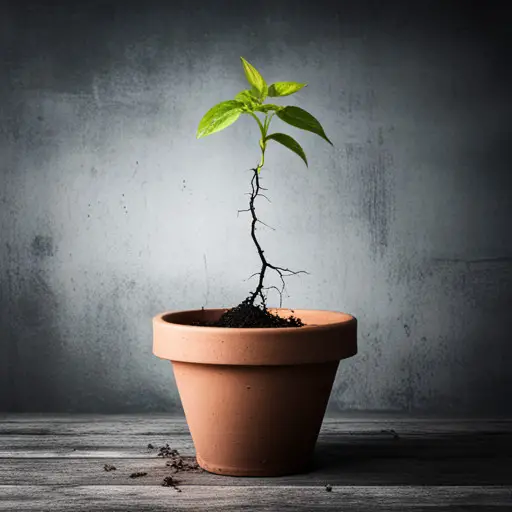You may have heard about insecure attachment styles before, but you might be thinking, “That doesn’t apply to me. I had a happy childhood.” However, it’s not just traumatic experiences that can lead to an insecure attachment style. In fact, anyone can develop one if they didn’t receive consistent love and support from their primary caregiver during infancy and childhood.
An insecure attachment style can affect your relationships with others in many ways. It can cause you to feel anxious or avoidant in intimate relationships, struggle with trust issues, and have difficulty expressing your emotions. But don’t worry – understanding the causes and effects of insecure attachment styles can help you manage them and build healthier connections with others. Let’s dive deeper into what an insecure attachment style is and how it can impact your life.
Key Takeaways
– Insecure attachment styles can be caused by inconsistent love and support from primary caregivers, childhood experiences of neglect or inconsistency, trauma and abuse, and genetic factors related to neurotransmitters like dopamine and oxytocin.
– The effects of insecure attachment styles can include anxiety or avoidance in intimate relationships, trust issues, difficulty expressing emotions, fear of abandonment or rejection, avoidant behavior, low self-esteem and self-worth, negative thoughts and behaviors, loneliness and isolation, and mental health concerns such as anxiety and depression.
– Managing insecure attachment styles can involve recognizing and understanding the causes and effects, seeking therapy or practicing self-reflection and communication skills, identifying triggers and practicing self-awareness, practicing self-care and self-compassion, being patient with oneself in the process of change, surrounding oneself with positive relationships, communicating with partners about triggers, acknowledging negative patterns in relationships, building connections with people who make one feel safe and supported, and focusing on personal growth and intentional improvement.
– It is possible to overcome insecure attachment styles with effort, patience, and a willingness to seek help and make positive changes in one’s life.
Understanding Insecure Attachment Styles

Let’s dive into what causes insecure attachment styles and how they manifest in relationships. An insecure attachment style is typically developed during childhood when a child does not receive enough emotional support or care from their primary caregiver. This can lead to the child feeling anxious or uncertain about their relationship with their caregiver, which can then translate into adult relationships.
Insecure attachment styles can show up in different ways, but a common manifestation is fear of abandonment or rejection. People with this type of attachment style may feel the need to constantly seek reassurance from their partner or become overly dependent on them. On the other hand, some individuals may develop avoidant behavior where they distance themselves emotionally and have difficulty trusting others.
It’s important to note that having an insecure attachment style does not mean that someone cannot have healthy and fulfilling relationships. However, it can require self-awareness and effort to work through any underlying issues that may be impacting one’s ability to form secure attachments. In the next section, we’ll explore some of the causes behind insecure attachment styles and how they can be addressed.
Causes of Insecure Attachment Styles

You may have developed an insecure attachment style due to a variety of causes. Childhood experiences, such as inconsistent caregiving or neglect, can lead to difficulties forming secure attachments in adulthood. Trauma and abuse during childhood can also contribute to insecure attachment styles, as well as genetic factors that may predispose individuals to certain attachment patterns.
Childhood Experiences
As a child, experiencing inconsistent care and affection can contribute to the development of an insecure attachment style. This may occur when parents are not able to provide consistent emotional support or when they do not respond appropriately to their child’s needs. For example, a child who is frequently left alone or ignored may develop an avoidant attachment style, while a child whose parents are sometimes loving and sometimes abusive may develop an anxious-ambivalent attachment style.
These childhood experiences can have long-lasting effects on a person’s ability to form healthy relationships in adulthood. However, it is important to note that not all children who experience inconsistent care develop insecure attachment styles, and it is possible for individuals with insecure attachments to overcome these challenges through therapy or other interventions. The next section will explore how trauma and abuse can also contribute to the development of insecure attachment styles.
Trauma and Abuse
Experiencing trauma and abuse during your formative years can have a significant impact on how you relate to others as an adult. This is especially true when it comes to attachment styles. Children who grow up experiencing trauma and abuse may develop an insecure attachment style, which can manifest in a variety of ways.
One way an insecure attachment style can manifest is through difficulty trusting others. This may stem from the fact that trust was broken at a young age, leading to feelings of betrayal and fear. Additionally, those with an insecure attachment style may struggle with intimacy, as they may associate closeness with vulnerability and danger. To better understand the impact of trauma and abuse on attachment styles, take a look at the table below:
| Trauma/Abuse | Impact on Attachment Style |
|---|---|
| ————– | ————————— |
| Physical Abuse | Fearful or Avoidant |
| Sexual Abuse | Disorganized or Ambivalent |
| Emotional Neglect | Anxious or Preoccupied |
As you can see from the table above, different types of trauma and abuse can lead to different patterns of attachment. In the next section, we’ll explore how genetics also play a role in shaping our attachment styles.
Genetics
Exploring the impact of genetics on our relationships, it’s fascinating to consider how nature and nurture interact to shape our connections with others. While genetics play a role in determining certain personality traits that can influence attachment styles, environmental factors such as parenting style and childhood experiences also heavily contribute to the development of attachment patterns.
In terms of genetics, research has found that specific genes related to neurotransmitters like dopamine and oxytocin can influence attachment behavior. Additionally, variations in the serotonin transporter gene have been linked to increased risk for insecure attachment styles. However, these genetic predispositions do not guarantee a particular attachment style; they simply increase the likelihood of developing one. It’s important to remember that our experiences and environment also significantly impact our relationship patterns.
Moving forward into exploring the effects of insecure attachment styles on relationships, it’s crucial to recognize the complex interplay between both nature and nurture in shaping these patterns.
Effects of Insecure Attachment Styles

If you have an insecure attachment style, you may struggle with forming and maintaining relationships. This can lead to feelings of loneliness and isolation. Additionally, low self-esteem and self-worth are common effects of insecure attachment styles, which can negatively impact your mental health.
Difficulty Forming and Maintaining Relationships
You may struggle to form and keep relationships due to your insecure attachment style. This can greatly impact your social life, as well as your mental and emotional wellbeing. Your attachment style affects how you interact with others and how you perceive their actions towards you.
Insecure attachment styles often lead to fear of abandonment or rejection, making it difficult for you to trust others or allow yourself to be vulnerable in a relationship. You may also have a tendency to push people away or become overly dependent on them, causing strain on the relationship. It is important to recognize these patterns in yourself and work towards building healthier relationships by seeking therapy or practicing self-reflection and communication skills.
| Struggles | Possible Solutions | Helpful Resources |
|---|---|---|
| :—: | :—: | :—: |
| Fear of abandonment/rejection | Practice vulnerability, communicate openly about feelings and needs | “Attached” by Amir Levine & Rachel Heller |
| Tendency to push people away or become overly dependent | Work on building self-confidence and independence | “The Power of Vulnerability” TED Talk by Brene Brown |
| Difficulty trusting others | Focus on building trustworthy friendships/relationships gradually over time | “Daring Greatly” by Brene Brown |
As you work towards improving your relationships, it is important to address any underlying issues that may be contributing to an insecure attachment style. One such issue is low self-esteem and self-worth which will be discussed further in the subsequent section.
Low Self-Esteem and Self-Worth
Having low self-esteem can greatly impact your mental health and overall wellbeing, leading to negative thoughts and behaviors. When you have an insecure attachment style, it is common to struggle with feelings of worthlessness or not feeling good enough for others. This can make forming and maintaining relationships difficult, as you may constantly seek validation from others or feel like you don’t deserve love and affection.
These feelings of inadequacy can also cause other mental health issues, such as anxiety and depression. You may find yourself constantly comparing yourself to others or putting yourself down, which only reinforces these negative beliefs about yourself. It’s important to recognize the impact that low self-esteem can have on your mental health and take steps towards building a more positive self-image.
Mental Health Issues
Mental health issues can be like a heavy backpack that you carry around every day, weighing you down and making it difficult to move forward. When you have an insecure attachment style, mental health issues can compound the problem and make it even more challenging to cope. Anxiety, depression, and other mental health concerns are common among those with an insecure attachment style.
These issues can manifest in a variety of ways, including difficulty trusting others, feeling disconnected or alone even when surrounded by people, and struggling with emotions such as anger or sadness. However, there are strategies that can help manage these challenges and allow individuals to develop healthier relationships.
How to Manage Insecure Attachment Styles

Managing insecure attachment styles can be challenging, but identifying triggers and practicing self-awareness can help you develop healthier patterns in your relationships. One way to manage an insecure attachment style is to recognize when you are feeling anxious or avoidant in a relationship. This could mean taking a step back and reflecting on why you are feeling this way. Are there certain behaviors or actions from your partner that trigger these feelings? Once you identify the triggers, you can work on communicating with your partner about how their actions make you feel.
Another way to manage an insecure attachment style is to practice self-care and self-compassion. It’s important to remember that everyone has their own insecurities and vulnerabilities, and it’s okay to have them too. Take time for yourself to do things that make you happy and fulfilled, whether it’s spending time with friends or pursuing a hobby. Additionally, try not to be too hard on yourself if you slip up in managing your attachment style. Remember that change takes time and effort.
In conclusion, managing an insecure attachment style requires patience, self-awareness, and communication skills. By recognizing triggers, practicing self-care, and being kind to yourself throughout the process of change, you can develop healthier patterns in your relationships over time. The next steps may involve seeking therapy or support from loved ones as needed. Remember that progress is possible with dedication and effort towards personal growth.
Conclusion and Next Steps

Now that you have learned some tactics to manage your insecure attachment style, let’s discuss what’s next. It’s important to remember that changing attachment patterns takes time and effort, but it’s definitely possible. You may find yourself slipping into old habits from time to time, but with practice, you can develop a more secure attachment style.
To continue on the path of healing and growth, here are some steps you can take:
– Seek therapy: Working with a therapist can provide valuable insight and support as you navigate your attachment style.
– Practice self-awareness: Pay attention to your thoughts and behaviors in relationships. Acknowledge when negative patterns arise and work towards addressing them.
– Surround yourself with positive relationships: Build connections with people who make you feel safe and supported.
– Be patient with yourself: Changing an attachment pattern is a process that takes time, so be kind to yourself along the way.
Keep in mind that while managing an insecure attachment style may seem daunting at first, it’s worth the effort for healthier relationships in the long run. By taking these steps and being intentional about your personal growth, you can create more fulfilling connections with others.
Conclusion
So, you’ve learned about insecure attachment styles and how they can affect your relationships. It’s important to remember that having an insecure attachment style is not a permanent state of being. With some effort and self-awareness, it is possible to change your attachment style and build healthier connections with others.
Take some time to reflect on your own behaviors and reactions in relationships. Are there patterns of avoidance or clinginess? Do you struggle with trust issues? By identifying these patterns, you can begin to work on changing them. Remember, Rome wasn’t built in a day – changing deeply ingrained habits takes time and patience.
As the saying goes, “you can’t pour from an empty cup.” By taking care of yourself first and foremost, you will be better equipped to form secure attachments with others. So start by giving yourself the love and attention that you deserve, and watch as your relationships flourish.

